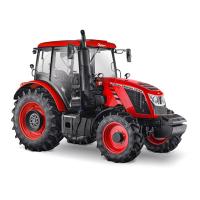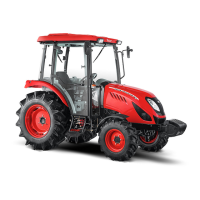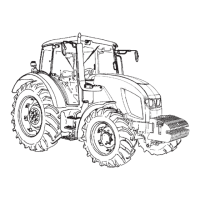Why is the clutch slipping on my Zetor HORTUS HS?
- AAndrea KnightSep 8, 2025
Clutch slippage on your Zetor Tractor could be due to incorrect adjustment (adjust the clearance) or worn or burned lining (have it repaired by an authorized service).

Why is the clutch slipping on my Zetor HORTUS HS?
Clutch slippage on your Zetor Tractor could be due to incorrect adjustment (adjust the clearance) or worn or burned lining (have it repaired by an authorized service).
What causes irregular engine operation in a Zetor Tractor?
Irregular engine operation in your Zetor Tractor could be due to air in the fuel system (bleed the system) or a clogged fuel filter (clean or replace the filter).
Why won't my Zetor Tractor starter work?
The starter may not work due to several reasons: * The clutch pedal might be released, so depress the clutch pedal. * The PTO switch may be set to the ON position, so set the PTO switch to the OFF position. * The battery may be dead, so charge the battery. * There might be loose contacts, so check for loose contacts and corrosion, then clean and tighten them. * The safety switch, switch, or starter itself may be defective, in which case you should have it repaired by an authorized service.
What causes black smoke from Zetor HORTUS HS engine?
Black smoke from your Zetor Tractor engine may be due to: * Low quality fuel: Add the specified fuel. For excessive fuel amount delivery or insufficient nozzle pressure, have it repaired by workshop.
Why won't the hydraulics lift on my Zetor HORTUS HS?
If the hydraulics on your Zetor Tractor aren't lifting, consider these possibilities: * Engine speed is too low: Increase the engine speed. * Lack of transmission oil: Refill the oil to the correct level. * Air leaks from the lines: Tighten the connections, or replace the pipe and sealing O-ring. * Suction filter clogged: Clean the filter and change oil. For defective pumps, hydraulic distributors or hydraulic valves, contact an authorized service center.
Why does the charge warning lamp come on while driving my Zetor HORTUS HS?
If the charge warning lamp illuminates during driving, it could indicate: * Defective wiring: Check for loose or missing terminals, short circuits, and poor grounding, and repair as necessary. * Defective alternator: Have it repaired by workshop. * Defective battery: Replace the battery. * Damaged fanbelt: Replace the belt.
What causes a Zetor HORTUS HS Tractor engine to stop suddenly?
A Zetor Tractor engine may stop suddenly due to: * Low fuel level: Refuel and bleed the system. Other potential causes, such as a defective nozzle or engine seizure, require repair by an authorized service.
How to troubleshoot insufficient power in Zetor HORTUS HS engine?
If your Zetor Tractor engine isn't producing enough power, the issue could be: * Clogged air cleaner: Clean the element. * Low fuel level: Add fuel. Other potential causes, such as a clogged or carboned nozzle tip, insufficient compression, improperly adjusted valve clearance, or incorrect injection timing, require repair by a workshop.
Why does the oil warning lamp come on in my Zetor Tractor?
The oil warning lamp in your Zetor Tractor might illuminate while driving due to: * Low engine oil level: Add oil to the specified level. * Low viscosity of engine oil: Change the engine oil with proper viscosity. * Faulty pressure switch: Replace the switch.
Why is the starter speed low on my Zetor Tractor?
Low starter speed in your Zetor Tractor can be caused by a low battery (charge the battery), poor grounding (clean and tighten the contacts), or incorrect engine oil viscosity (replace with engine oil of the correct viscosity).
Explains the purpose, importance, and maintenance of ROPS for operator protection.
Critical safety measures for ROPS, seat belts, tipping prevention, and fuel handling.
Safe maintenance procedures and warnings about high-pressure fluids.
Procedures for preventing battery explosions, acid burns, and safe disconnection.
Safety during service, engine starting, and cab emergency exits.
Safety guidelines for operating loaders, towing equipment, FOPS, and OPS.
Safe tractor operation, maintenance tips, and implement handling procedures.
Step-by-step instructions for safely starting and stopping the tractor engine.
General guidance and safety precautions for operating the tractor on various terrains.
Proper engagement and use of the differential lock for enhanced traction.
Safe procedures for connecting, disconnecting, and mounting tractor implements.
Overview of service schedules, inspections, and essential pre-start checks.
Procedures for checking and changing engine oil, transmission oil, and front axle oil.
Cleaning and changing oil filters, fuel filters, and pre-filters.
Procedures for replacing coolant, anti-freeze, and cleaning the radiator.
Battery maintenance, charging, disconnection, and fuse replacement procedures.
Checking drive belts, air cleaner service, and checking hoses/lines.
Guide for diagnosing and resolving common engine operational issues and symptoms.
Troubleshooting for clutch, brake, and hydraulic system malfunctions.











